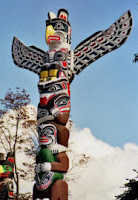FIRST NATIONS - Totem Poles
Totem poles are monuments created by First Nations of the Pacific Northwest to represent and commemorate ancestry, histories, people, or events. Totem poles are typically created out of red cedar, a malleable wood relatively abundant in the Pacific Northwest, and would be erected to be visible within a community.
The First Nations are the various Aboriginal peoples in Canada who are neither Inuit nor Métis. There are currently over 630 recognized First Nations governments or bands spread across Canada, roughly half of which are in the provinces of Ontario and British Columbia. The total population is nearly 700,000 people. Under the Employment Equity Act, First Nations are a "designated group", along with women, visible minorities, and persons with physical or mental disabilities. They are not defined as a visible minority under the Act or by the criteria of Statistics Canada.
The term First Nations (most often used in the plural) has come into general use for the indigenous peoples of the Americas located in what is now Canada, except for the Arctic-situated Inuit, and peoples of mixed European-First Nations ancestry called Métis. The singular, commonly used on culturally politicized reserves, is the term First Nations person (when gender-specific, First Nations man or First Nations woman).
Most totem poles display beings, or crest animals, marking a family’s lineage and validating the powerful rights and privileges that the family held. Totem poles would not necessarily tell a story so much as it would serve to document stories and histories familiar to community members or particular family or clan members.
A totem pole typically features symbolic and stylized human, animal, and supernatural forms.1 Totem poles are primarily visual representations of kinship, depicting family crests and clan membership. For example, some Kwakwaka'wakw families of northern Vancouver Island belonging to the Thunderbird Clan will feature a Thunderbird crest and familial legends on their poles. Other common crests among coastal First Nations include the wolf, eagle, grizzly bear, thunderbird, killer whale, frog, raven, and salmon.2 Wealthy and influential families may have more than one crest. Totem poles can also be created to honor a particular event or important person. Read more...
In most cases, a totem is a carved tribal figure, usually a pillar engraved and painted with religious or nature symbols. From where totem poles originated is actually not known. They are made from wood and as such, rot and decay over time.
Consequently, there are no poles that exist today that were carved prior to the 1800s. We do know that totem poles were present in North America prior to 1800 because of accounts from early explorers. Presumably, totem poles seen by the early explorers were preceded by a long history of such carving, and it is assumed these were predominantly house support beams. Design differences between totem poles is regional and most likely a product of artistic techniques.
Totem pole carving declined at the end of the nineteenth century largely due to American and Canadian native assimilation programs. Assimilation (from Latin assimilatio; "to render similar") may refer to:
- Linguistics
- Culture
- Sociology
- Biology
- Meteorology
- Psychology
- Religious
and the all popular:
AMERICANIZATION . . .





No comments:
Post a Comment